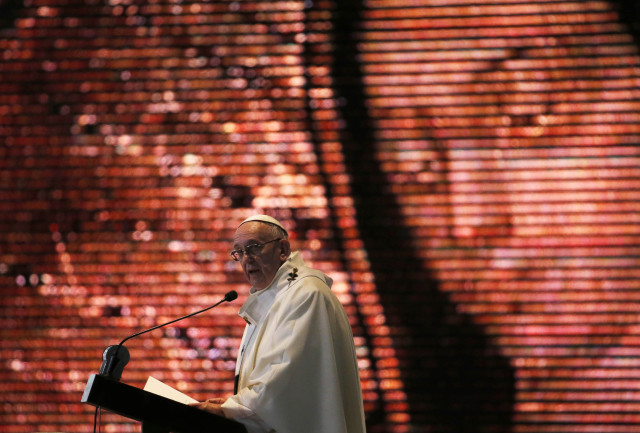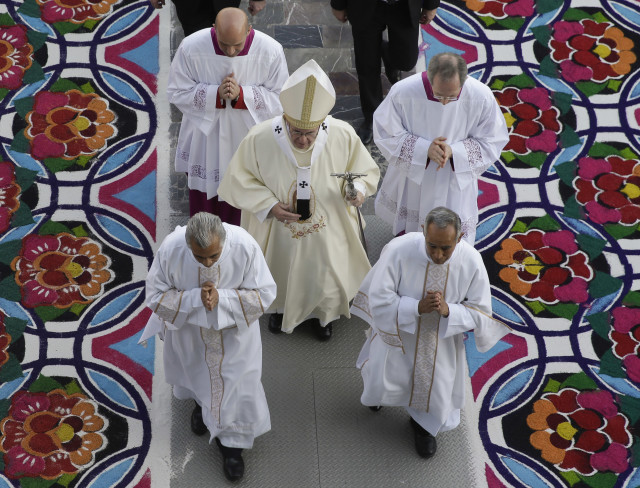In the Path of a Political Pope
By Destinee Harrison and Cate Malek
Reporting Texas

Pope Francis celebrates Mass at the Basilica of the Virgin of Guadalupe in Mexico City. (Marco Ugarte/AP Photo)
Pope Francis will use his trip to the border between the U.S. and Mexico on Wednesday to engage with some of the most controversial and painful political issues facing both countries.
On his journey through Mexico, Francis chose to include cities that have been most affected by long-running crises such as migration and drug violence. As such, his weeklong visit has attracted the attention of scholars since it was announced in December.
Reporting Texas spoke with experts from U.S. universities who have been studying the political implications of the pope’s activist theology.
The pope “is Latin American, and he understands how important Mexico is and how much it has suffered,” said Virginia Garrard-Burnett, a history professor at the University of Texas at Austin who studies the intersection of religion and politics in Latin America.
One of the key stops on his trip will be Juarez, the border city the U.S. news media have referred to as the murder capital of the world. In 2010, there were 8.5 killings a day due to escalating gang violence, according to the Chihuahua State Attorney General’s Office. Today, local officials say that Juarez is once again a safe place to visit. But the city is still struggling with the legacy of that violence.

Pope Francis’s homily dealt with the story of the Virgin of Guadalupe, who is said to have appeared to an indigenous man, Juan Diego, in 1531, to ask that a church be built in her name. (Gregorio Borgia/AP Photo)
“You are living your little piece of war,” Francis told the Mexican people in Spanish on Feb. 3, in an address broadcast by the Notimex news agency. “The Mexico of violence, the Mexico of corruption, the Mexico of drug trafficking, the Mexico of cartels, is not the Mexico that our mother [the Virgin Mary] wants. I, of course, will not cover any of that up,” he said.
This message will likely not be popular with many Mexican officials, who have stressed the religious rather than the political aspects of the visit. The pope’s focus on the violence in the country draws attention to the fact that President Enrique Peña Nieto has failed to achieve his campaign promises to bring law and order to Mexico. Even the reduction of violence in Juarez is widely attributed to what many sources say is the control of the city by one cartel, rather than any actions on the government’s part.
The pope has continued to push his agenda nonetheless.
“He is just not a person who is afraid,” said Garrard-Burnett.
Part of this agenda will be reaching out to the indigenous people of Mexico who were historically persecuted by the Catholic Church. Saturday, Francis said a Mass at the shrine to the Virgin of Guadalupe in Mexico City. In the story of the Virgin of Guadalupe, a brown-skinned Virgin Mary appeared to an indigenous man, Juan Diego, and asked that a namesake church be established on the spot.
Peter Casarella, a Notre Dame professor who specializes in Latino theology, said the story of the Virgin of Guadalupe represents “the hope for the end of violence, the hope for the end of conquest, the hope for the end of religion that belonged to other people and the beginning of a Christian vision of God that comes from the mestizos, comes from the indigenous, comes from below, as it were.” Later in the trip, the pope will underscore this message by traveling to San Cristobal de Las Casas, in the southernmost state of Chiapas, on the border with Guatemala. There, he will meet with indigenous leaders and conduct another Mass on Monday.
Francis’ journey also has implications for U.S. politics. His final event will be a cross-border Mass for the people of Juarez and El Paso on Wednesday. More than 250,000 people are expected to attend the Mass in Juarez and another 50,000 will participate in the Mass at the Sun Bowl, on the campus of the University of Texas at El Paso.
“There will be priests on both sides of the border saying the Mass together, but what is separating the altars is the fence,” said John Burke, a St. Edwards University professor who focuses on religion, politics, and social justice. “You have believers coming to participate in liturgy and communion, and yet at the same time, politically, there is clearly this separation, which needs to be addressed.”
Undocumented immigrants from all over Latin America cross the Mexican border into the U.S., often to find work. In 2014, an estimated 11.3 million unauthorized people were living in the United States, according to the Pew Research Center. Almost half, 5.6 million, were Mexican immigrants, with Texas being home to one of the largest immigrant populations.
Pope Francis is expected to call attention to the extreme dangers that migrants face. According to the U.S. Border Patrol, 240 immigrants perished crossing the U.S.-Mexico border in 2015, a drop from 340 the year before, according to the U.S. Border Patrol. During Francis’ visit, a group of mothers of migrants who have disappeared while trying to cross the border are expected to present a letter to the pope, beseeching his help in finding their children.
The symbolic message of the cross-border Mass is in contrast to much of the rhetoric from conservative U.S. politicians, who have talked about the need to build a wall between the two countries. But it is also characteristic of Pope Francis, who has a history of making dramatic and often spontaneous gestures, such as when he unexpectedly visited the wall separating Israel and Palestine in 2014.
“Pope Francis is trying to provoke the U.S. and Mexican government to get together to try and come up with a sensible immigration policy,” Burke said.
Although Francis’ trip may raise some controversy, his goal is ultimately one of healing. Representatives from the El Paso Diocese have emphasized that the Mass is meant to bring attention to the bonds of culture, language and religion between their city and Juarez.
“We are two nations, one community,” said Elizabeth O’Hara, the communications director for the diocese. “And this is an opportunity for us to show the world how a community of immigrants can live peacefully.”